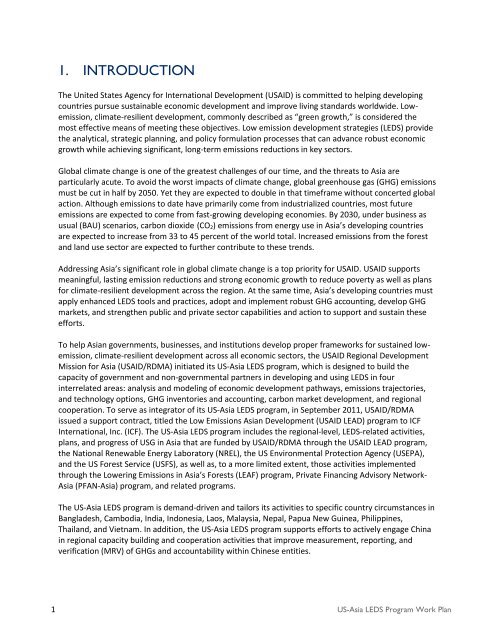ASIA LOW EMISSION DEVELOPMENT STRATEGIES (LEDS) WORK PLAN
PA00MMKZ
PA00MMKZ
Create successful ePaper yourself
Turn your PDF publications into a flip-book with our unique Google optimized e-Paper software.
1. INTRODUCTION<br />
The United States Agency for International Development (USAID) is committed to helping developing<br />
countries pursue sustainable economic development and improve living standards worldwide. Lowemission,<br />
climate-resilient development, commonly described as “green growth,” is considered the<br />
most effective means of meeting these objectives. Low emission development strategies (<strong>LEDS</strong>) provide<br />
the analytical, strategic planning, and policy formulation processes that can advance robust economic<br />
growth while achieving significant, long-term emissions reductions in key sectors.<br />
Global climate change is one of the greatest challenges of our time, and the threats to Asia are<br />
particularly acute. To avoid the worst impacts of climate change, global greenhouse gas (GHG) emissions<br />
must be cut in half by 2050. Yet they are expected to double in that timeframe without concerted global<br />
action. Although emissions to date have primarily come from industrialized countries, most future<br />
emissions are expected to come from fast-growing developing economies. By 2030, under business as<br />
usual (BAU) scenarios, carbon dioxide (CO 2) emissions from energy use in Asia’s developing countries<br />
are expected to increase from 33 to 45 percent of the world total. Increased emissions from the forest<br />
and land use sector are expected to further contribute to these trends.<br />
Addressing Asia’s significant role in global climate change is a top priority for USAID. USAID supports<br />
meaningful, lasting emission reductions and strong economic growth to reduce poverty as well as plans<br />
for climate-resilient development across the region. At the same time, Asia’s developing countries must<br />
apply enhanced <strong>LEDS</strong> tools and practices, adopt and implement robust GHG accounting, develop GHG<br />
markets, and strengthen public and private sector capabilities and action to support and sustain these<br />
efforts.<br />
To help Asian governments, businesses, and institutions develop proper frameworks for sustained lowemission,<br />
climate-resilient development across all economic sectors, the USAID Regional Development<br />
Mission for Asia (USAID/RDMA) initiated its US-Asia <strong>LEDS</strong> program, which is designed to build the<br />
capacity of government and non-governmental partners in developing and using <strong>LEDS</strong> in four<br />
interrelated areas: analysis and modeling of economic development pathways, emissions trajectories,<br />
and technology options, GHG inventories and accounting, carbon market development, and regional<br />
cooperation. To serve as integrator of its US-Asia <strong>LEDS</strong> program, in September 2011, USAID/RDMA<br />
issued a support contract, titled the Low Emissions Asian Development (USAID LEAD) program to ICF<br />
International, Inc. (ICF). The US-Asia <strong>LEDS</strong> program includes the regional-level, <strong>LEDS</strong>-related activities,<br />
plans, and progress of USG in Asia that are funded by USAID/RDMA through the USAID LEAD program,<br />
the National Renewable Energy Laboratory (NREL), the US Environmental Protection Agency (USEPA),<br />
and the US Forest Service (USFS), as well as, to a more limited extent, those activities implemented<br />
through the Lowering Emissions in Asia’s Forests (LEAF) program, Private Financing Advisory Network-<br />
Asia (PFAN-Asia) program, and related programs.<br />
The US-Asia <strong>LEDS</strong> program is demand-driven and tailors its activities to specific country circumstances in<br />
Bangladesh, Cambodia, India, Indonesia, Laos, Malaysia, Nepal, Papua New Guinea, Philippines,<br />
Thailand, and Vietnam. In addition, the US-Asia <strong>LEDS</strong> program supports efforts to actively engage China<br />
in regional capacity building and cooperation activities that improve measurement, reporting, and<br />
verification (MRV) of GHGs and accountability within Chinese entities.<br />
1 US-Asia <strong>LEDS</strong> Program Work Plan

















